Prelude: An introduction to Fred Hoyt’s travels with students
I discovered international travel late, about the same time that I came to Illinois Wesleyan University.
Part of my enlightenment occurred in 1989, when my son, David, was in Europe—for the third time. I mentioned to my wife that we had always wanted to go to Europe, but we had felt we couldn’t afford it—and we couldn’t afford it now because we had been sending him. The logic escaped me.
A little later, she confessed that she had thought about it. The result? “I have tickets so we can join him in Paris for Christmas and New Year’s.”
“But I always go cross country skiing with my troop at that time,” I retorted.
“Which would you rather do?”
“Where should I send you the postcard from Eagle River?”
“You can take the exam as many times as you want until you get it right,” she offered. The third time I got it right.
Paris at Christmas. Midnight mass in Notre Dame, one of the most moving experiences of my life. Christmas ’89 also marked the end of the evil empire. Our hotel was around the corner from the Rumanian embassy, and the anti-Ceausescu crowd besieged the embassy as we watched his fall and execution on the TV. It was exhilarating to see so many places we would read about or had seen in picture books. It stoked my appetite for travel.
There was a trip to China, through IWU, that followed in 1990. I was chosen with Tom Griffiths to accompany an ISU delegation as guests of the China Publication Bureau. The Bureau sent some employees each year to ISU, and in return hosted ISU (and IWU) faculty members. It was a dream come true. China–from Hong Kong to Guangzhou, Kunming, Shanghai, Xian and Beijing.
My long-disused Chinese (3 years at the University of Illinois) returned. I visited places I’d not only read about, but written about in my dissertation. I imagined gunboats at Shanghai, kowtowing to the Emperor in the Forbidden City, or wreaking havoc at the old Summer Palace. An exotic atmosphere marked our trip from Kunming to Dali (home of the Bai nationality. The 11-hour bus ride with academics on the old Burma Road was punctuated with verses of “Hello Dali,” and puns touting the best bais (the dominant nationality) in Dali. By the end of the trip, I understood why the people I had written about in my dissertation, “Americans in China and the Myth of the China Market,” never wanted to come home. I did not either.
An epiphany took place a year or two later, as I sat and mused at the Florida Keys with my Scout troop. The leisure gave me an opportunity to ponder what it meant to be 50. I realized that I had better do what I wanted to do whenever I had the chance. It was as true at 20 as at 50, but I’m glad I had the impetus to seize whatever opportunities I had—and to make some I didn’t have. For the next almost thirty years, I traveled whenever I could. And it started to come down to at least 4 options, one of which is the primary emphasis of this book, the January and then May term trips with Illinois Wesleyan students.
My first trip was in January 1994 (see the next entry). The 1994 visits gradually spread to include other Asian countries, revealing the historical importance of China, and watching the rebirth of the dragon. In 2001—the last trip before 9/11—it was an ambitious venture around the world, via London to New Delhi, to Bangkok, Bali, Saigon, and Hong Kong. Many stops at the airport hotel in Bangkok, since most of the flights were on Thai Air, and routed through the capital of Thailand. I also ventured into parts of Europe, culminating in 2013, which went from London to (for me) Lvov.
May added opportunities to extend the trips and go places I probably wouldn’t take students—such as Mongolia, Tibet, and parts of Eastern Europe. These are included here.
 Some of those were with my wife. Carolyn, who her own professional career, and thus had fewer opportunities to join me, given the constraints of her job. Nevertheless, Carolyn came on parts of trips, sometimes during and sometimes for extended trips afterwards. She was especially intrigued by a Baltic visit as a chaperone to the IWU choir. I promised instead that we would go cruising, and I kept my word. That began over a decade of trips, mostly Europe and the Mediterranean, which culminated in a land tour in March 2020, when Covid and we arrived at about the same time in Spain. She accompanied me on a number of business conference trips, including Viet Nam (shortly after it was opened to foreigners), my 1997 sabbatical to India and Southeast Asia, New Zealand, and China/Korea. These are documented in my blogs, but, unless connected with student trips, not in
Some of those were with my wife. Carolyn, who her own professional career, and thus had fewer opportunities to join me, given the constraints of her job. Nevertheless, Carolyn came on parts of trips, sometimes during and sometimes for extended trips afterwards. She was especially intrigued by a Baltic visit as a chaperone to the IWU choir. I promised instead that we would go cruising, and I kept my word. That began over a decade of trips, mostly Europe and the Mediterranean, which culminated in a land tour in March 2020, when Covid and we arrived at about the same time in Spain. She accompanied me on a number of business conference trips, including Viet Nam (shortly after it was opened to foreigners), my 1997 sabbatical to India and Southeast Asia, New Zealand, and China/Korea. These are documented in my blogs, but, unless connected with student trips, not in this book.
this book.
Another companion on trips and after trips was my son, David, whose long efforts on the fringes of the academy left him freer than Carolyn to join me, and so father and son traveled to Laos, Malaysia, Indonesia, Central China, and the Wild West of Xinjiang.
 A third fellow traveler was a student turned alumni, JR Glen. An Eagle Scout from Lincoln, JR was a great assist as we visited Tibet, Mongolia, and Burma.
A third fellow traveler was a student turned alumni, JR Glen. An Eagle Scout from Lincoln, JR was a great assist as we visited Tibet, Mongolia, and Burma.
Carolyn was a little uncomfortable with my traveling alone, but I did so in Eastern Europe and various places in “the East.” I would arrange the addons with (usually) Value Holidays of Mequon Wisconsin who would see to it I had guides and hotels and transportation. Thus, on my own, I explored Cambodia, Manchuria, Korea, Yunnan, and other parts of Chinese. With a combination of hubris and a modest but improving Chinese vocabulary, I might add.
The travel courses that I either led or seconded were among the most rewarding experiences I had at IWU, and I think they were appreciated, or at least remembered, by participants. As I was compiling these blogs and recreating some missing gaps (it’s amazing how much I remembered!), I drew on their pictures too, many of them still posted on Facebook at a distance of over a decade. Pictures up despite many of them drowning their posts in contemporary portraits of their growing families! I thank them for their contributions to my memories of IWU—and for their shared pictures.
After 2013, my trips changed. came courtesy (in part) of the US Government. In an effort to educate business people and faculty, the government funded several university outreaches. The Faculty Development in International Business (FDIB) afforded me opportunities to travel with other faculty to explore business and culture in foreign countries. I went on in the 1990s to China, Hong Kong, and Bangkok, and realized these would be good preparation for my student trips. The University provided initial funding through a grant, and the trips became addictive. Most were supported by the “Fred Foundation,” investments in knowledge and pleasure. When IWU curtailed my May terms, the FDIB trips to Cuba, Latin America, and Africa expanded my knowledge of international business.
And finally, I continued to travel with Carolyn as we cruised the Mediterranean and European rivers.
My recollections (contemporary or otherwise) are in the blog, if you’re interested. As I said, this particular collection is focused on the student trips for nearly two decades.
Safe travels and good reading; what a combination.
Frederick Hoyt, Emeritus Associate Professor of Business, June 2025
 I was (and still am) fascinated with Qingdao, and in May 1996, after leading a May Term, indulged that interest in touring the Shantung peninsula. It was my first trip in China on my own, which meant, essentially, going from town to town in a car with driver. The driver was Feng Hong, or “red wind,” a classic Cultural Revolution name. His English was confined to “Michael Jordan #1,” incontestably true for the greatest of all time. In fact, one of my fondest memories of Michael Jordan was watching a finals game in a yogwan in Korea (a room with a condom dispenser). The announcer (Taiwanese) watched Jordan float from the top of the key to the basket, and said, “Wow.” Not a Chinese word, but a universal description of MJ.
I was (and still am) fascinated with Qingdao, and in May 1996, after leading a May Term, indulged that interest in touring the Shantung peninsula. It was my first trip in China on my own, which meant, essentially, going from town to town in a car with driver. The driver was Feng Hong, or “red wind,” a classic Cultural Revolution name. His English was confined to “Michael Jordan #1,” incontestably true for the greatest of all time. In fact, one of my fondest memories of Michael Jordan was watching a finals game in a yogwan in Korea (a room with a condom dispenser). The announcer (Taiwanese) watched Jordan float from the top of the key to the basket, and said, “Wow.” Not a Chinese word, but a universal description of MJ.
 I also remember asking Feng Hong to stop at one point so I could take pictures of a harvesting team of machinery that was the most mechanized agriculture I had ever seen in China. Combines in China. A first.
I also remember asking Feng Hong to stop at one point so I could take pictures of a harvesting team of machinery that was the most mechanized agriculture I had ever seen in China. Combines in China. A first. One other stop was a note worthy: Qu’fu, the home of the Great Sage, Confucius. The main shrine was massive, a paean to the importance (reemphasized in contemporary
One other stop was a note worthy: Qu’fu, the home of the Great Sage, Confucius. The main shrine was massive, a paean to the importance (reemphasized in contemporary  China) of a philosopher who encouraged order and obedience. The Confucian exams for centuries defined winners and losers in the civil service, and remnants of the rote learning it required are still embedded in China’s educational system. Qu’fu was one of the few places in China I saw stars and heard birds (not in cages). It was tranquil, in other words.
China) of a philosopher who encouraged order and obedience. The Confucian exams for centuries defined winners and losers in the civil service, and remnants of the rote learning it required are still embedded in China’s educational system. Qu’fu was one of the few places in China I saw stars and heard birds (not in cages). It was tranquil, in other words. The literal highlight of course was Tai Shan, one of the most sacred mountains in China. It’s where Mao said, “The East is Red,” but Confucius sagely remarked, “The Earth is small.” I stayed in a Chinese-speaking
The literal highlight of course was Tai Shan, one of the most sacred mountains in China. It’s where Mao said, “The East is Red,” but Confucius sagely remarked, “The Earth is small.” I stayed in a Chinese-speaking guesthouse. At an ungodly hour, the phone rang and a voice announced (my translation—get up and get dressed, daybreak is coming). There was a PLA topcoat in the closet to protect me from the mountain chill; I threw it on and joined the throngs there to watch the sun come up over China. You can see me in the pictures: I’m the one without the cigarette.
guesthouse. At an ungodly hour, the phone rang and a voice announced (my translation—get up and get dressed, daybreak is coming). There was a PLA topcoat in the closet to protect me from the mountain chill; I threw it on and joined the throngs there to watch the sun come up over China. You can see me in the pictures: I’m the one without the cigarette.


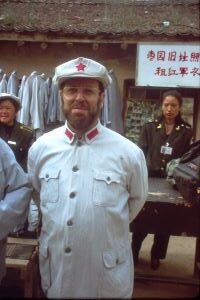

 off, May term prospered, and as evidenced by the material in the blog, I enjoyed the opportunity to travel in May with students, and after those trips without them. However, May term classes were no longer required for faculty or students. That meant a harder sell to attract students and some
off, May term prospered, and as evidenced by the material in the blog, I enjoyed the opportunity to travel in May with students, and after those trips without them. However, May term classes were no longer required for faculty or students. That meant a harder sell to attract students and some  maneuvering to get to lead one of the trips, since it meant faculty taught fewer courses during the regular year. For me, I sometimes combined sections of classes to get the six, sometimes went as a co-leader, sometimes (to the annoyance of the administration), led a trip without it being part of my teaching responsibilities–i.e., taught for free. On occasion, I even (for the first JTerm) wound up paying for the trip myself.
maneuvering to get to lead one of the trips, since it meant faculty taught fewer courses during the regular year. For me, I sometimes combined sections of classes to get the six, sometimes went as a co-leader, sometimes (to the annoyance of the administration), led a trip without it being part of my teaching responsibilities–i.e., taught for free. On occasion, I even (for the first JTerm) wound up paying for the trip myself.


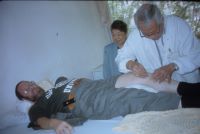

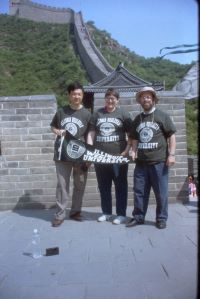
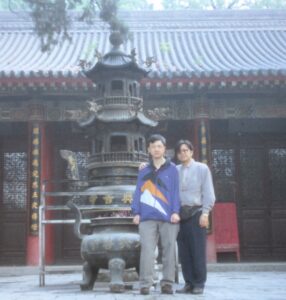 reported that his airline ticket and passport had been stolen. While our suspicion was that he had been inebriated, he still needed those documents to continue the journey. Fortunately, Dr. Jin and Mr. Li were able to convince the airline and the consulate to reissue the documents. What a predicament that could have been!
reported that his airline ticket and passport had been stolen. While our suspicion was that he had been inebriated, he still needed those documents to continue the journey. Fortunately, Dr. Jin and Mr. Li were able to convince the airline and the consulate to reissue the documents. What a predicament that could have been! A chance visit in Nanjing was to a restaurant–in what had been the home of Chiang Kai-shek as president of China before World War II. He gave it to his wife, and it’s now known as Mei-ling’s palace. What a surprise that was!
A chance visit in Nanjing was to a restaurant–in what had been the home of Chiang Kai-shek as president of China before World War II. He gave it to his wife, and it’s now known as Mei-ling’s palace. What a surprise that was! there, Carolyn and I got our picture taken in the Shanghai Room. A great feeling in the Great Hall!
there, Carolyn and I got our picture taken in the Shanghai Room. A great feeling in the Great Hall!








 but was caught in the emotionalism of the made for TV series. Believed President (Fred as Cold warrior ala Kennedy)
but was caught in the emotionalism of the made for TV series. Believed President (Fred as Cold warrior ala Kennedy)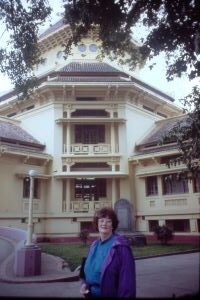

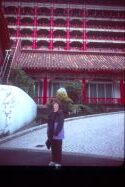

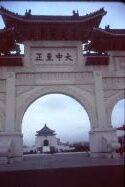






 January term class, which might be international.
January term class, which might be international.
 (nonexistent because it was cobbled together with faculty who had appointments in other departments, but taught an International Studies class), offered me the opportunity to develop a course on Trade and Diplomacy on the China Coast for International Studies credit. That was my 1994 segue into teaching a travel course for almost 20 years at IWU. It started in China, but gradually expanded to East and Southeast Asia, to Europe, and in 2001, a trip around the world. Most were in business.
(nonexistent because it was cobbled together with faculty who had appointments in other departments, but taught an International Studies class), offered me the opportunity to develop a course on Trade and Diplomacy on the China Coast for International Studies credit. That was my 1994 segue into teaching a travel course for almost 20 years at IWU. It started in China, but gradually expanded to East and Southeast Asia, to Europe, and in 2001, a trip around the world. Most were in business.
 The two memories that stand out the most to me from this trip both involved Xiamen, one of my favorite cities in China. Known as Amoy in earlier days, it had, on the island of Kulangsu, the “other” International Settlement (other than Shanghai) from imperialist days.
The two memories that stand out the most to me from this trip both involved Xiamen, one of my favorite cities in China. Known as Amoy in earlier days, it had, on the island of Kulangsu, the “other” International Settlement (other than Shanghai) from imperialist days.



 We were going to Guangzhou and staying on Shamian Island, which still had many of the old colonial buildings from the days it was THE international area. Cannons from the Opium War, sites from the postcards I collected!
We were going to Guangzhou and staying on Shamian Island, which still had many of the old colonial buildings from the days it was THE international area. Cannons from the Opium War, sites from the postcards I collected!
 Kuomintang-controlled Taiwan, it had been a military base and not much changed had been allowed. The accommodation was at a hotel with a honeymoon suite. John Archer and I shared it (only one faculty member
Kuomintang-controlled Taiwan, it had been a military base and not much changed had been allowed. The accommodation was at a hotel with a honeymoon suite. John Archer and I shared it (only one faculty member  was required at the time), with a vibrating heart shaped bed. Don’t ask. The boys came back disappointed from the massage parlor, complaining that they had gotten only a massage.
was required at the time), with a vibrating heart shaped bed. Don’t ask. The boys came back disappointed from the massage parlor, complaining that they had gotten only a massage.
 Beijing meant visiting the impressive sites that had dazzled and overwhelmed visitors from other countries, convincing them that China was the Middle Kingdom, a superior civilization. And of course, we spent time along the Great Wall, which had been a vain effort to keep the
Beijing meant visiting the impressive sites that had dazzled and overwhelmed visitors from other countries, convincing them that China was the Middle Kingdom, a superior civilization. And of course, we spent time along the Great Wall, which had been a vain effort to keep the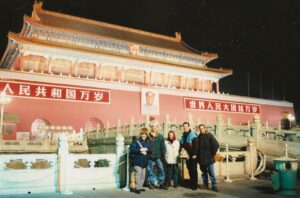 barbarians at bay and to mark the end of the civilized world. Being winter, many of the students purchased warm winter coats at the Red Army store I asked our guide to find for us.
barbarians at bay and to mark the end of the civilized world. Being winter, many of the students purchased warm winter coats at the Red Army store I asked our guide to find for us.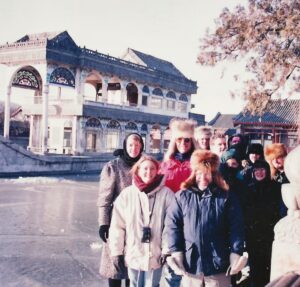
 with Samsung. The son got an independent study course so he could return to Seoul for J Term. The grateful dad provided us with a guide, a bus, and all the meals we desired, and we went to Panmunjom, Samsung, and the King Sejong grave (he invented the Korean alphabet)
with Samsung. The son got an independent study course so he could return to Seoul for J Term. The grateful dad provided us with a guide, a bus, and all the meals we desired, and we went to Panmunjom, Samsung, and the King Sejong grave (he invented the Korean alphabet) . As our last meal in Asia, he provided us with a meal at a private dining room at the top of the tallest building (at the time) in Asia, which included chateaubriand.
. As our last meal in Asia, he provided us with a meal at a private dining room at the top of the tallest building (at the time) in Asia, which included chateaubriand. Reminiscences 2024
Reminiscences 2024






 Chinese (3 years at the University of Illinois) returned. I visited places I’d not only read about, but written about in my dissertation. I imagined gunboats at Shanghai, kowtowing to the Emperor in the Forbidden City, or wreaking havoc at the old Summer Palace. An exotic atmosphere marked our trip from Kunming to Dali (home of the Bai nationality. The 11-hour bus ride with academics on the old
Chinese (3 years at the University of Illinois) returned. I visited places I’d not only read about, but written about in my dissertation. I imagined gunboats at Shanghai, kowtowing to the Emperor in the Forbidden City, or wreaking havoc at the old Summer Palace. An exotic atmosphere marked our trip from Kunming to Dali (home of the Bai nationality. The 11-hour bus ride with academics on the old







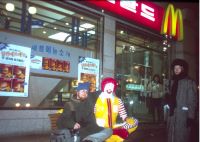

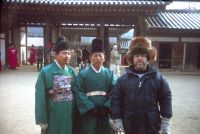
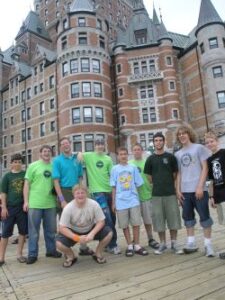




 Some of those were with my wife. Carolyn, who her own professional career, and thus had fewer opportunities to join me, given the constraints of her job. Nevertheless, Carolyn came on parts of trips, sometimes during and sometimes for extended trips afterwards. She was especially intrigued by a Baltic visit as a chaperone to the IWU choir. I promised instead that we would go cruising, and I kept my word. That began over a decade of trips, mostly Europe and the Mediterranean, which culminated in a land tour in March 2020, when Covid and we arrived at about the same time in Spain. She accompanied me on a number of business conference trips, including Viet Nam (shortly after it was opened to foreigners), my 1997 sabbatical to India and Southeast Asia, New Zealand, and China/Korea. These are documented in my blogs, but, unless connected with student trips, not in
Some of those were with my wife. Carolyn, who her own professional career, and thus had fewer opportunities to join me, given the constraints of her job. Nevertheless, Carolyn came on parts of trips, sometimes during and sometimes for extended trips afterwards. She was especially intrigued by a Baltic visit as a chaperone to the IWU choir. I promised instead that we would go cruising, and I kept my word. That began over a decade of trips, mostly Europe and the Mediterranean, which culminated in a land tour in March 2020, when Covid and we arrived at about the same time in Spain. She accompanied me on a number of business conference trips, including Viet Nam (shortly after it was opened to foreigners), my 1997 sabbatical to India and Southeast Asia, New Zealand, and China/Korea. These are documented in my blogs, but, unless connected with student trips, not in this book.
this book. A third fellow traveler was a student turned alumni, JR Glen. An Eagle Scout from Lincoln, JR was a great assist as we visited Tibet, Mongolia, and Burma.
A third fellow traveler was a student turned alumni, JR Glen. An Eagle Scout from Lincoln, JR was a great assist as we visited Tibet, Mongolia, and Burma.